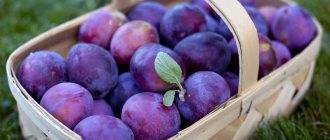Potatoes are an integral part of our diet, so we want them to be of ideal quality, and even better, from our home garden. And if in the private sector there are no special problems with storing potatoes, then residents of multi-storey buildings have a more difficult time.
From the article you will learn how to store potatoes on the balcony in winter so that they retain their natural taste, marketable appearance and beneficial properties.
Suitable conditions for storing potatoes on the balcony
To store the crop, choose a dry, dark room with good air circulation, protected from moisture, dust and insects.
The optimal temperature for storing potatoes is considered to be +2...+6°C and humidity - 70–80%. If the storage location is too warm in winter, the potatoes will “feel” the approach of spring and begin to sprout.
At what temperature do potatoes freeze on the balcony? At 0°C, the starch contained in the tubers will turn into sugar, and at sub-zero temperatures the tubers will disappear.
Is there a difference in storage: on a heated and unheated balcony?
The recommended storage temperature of +2...+6°C will be constant on a heated balcony thanks to the installed floor heating system. In this case, the potatoes are placed in a cardboard box or any ventilated container.
But on an unheated balcony there is a high risk of a drop in air temperature. In this case, to ensure optimal conditions, the storage container is equipped with additional heating.
Is there a difference: glazed and unglazed balcony
An open balcony is unsuitable for storing vegetables in winter. Sharp strong winds, high humidity, and regular temperature changes are disastrous conditions for vegetables. Therefore, insulated structures are constructed on such a balcony.
It is prohibited to use electrical appliances, as they will not be able to work properly in an inappropriate place.
Preparing potatoes for wintering
Any harvest is easy to preserve if you properly prepare the material and create optimal storage conditions. Doing this in a city apartment is not easy, but it is possible. The room is too warm, so in winter it is better to keep the potatoes on the balcony.
A few recommendations on how to properly store potatoes on the balcony in winter:
- It is preferable to store late varieties, for example: “Nevsky”, “Sineglazka”, “Udacha”. Early ripening varieties deteriorate faster than others, losing their beneficial properties and taste. It is not advisable to store them on the balcony in winter. Mid-ripening varieties are good for growing in central Russia and are suitable for storage in the same way as late-ripening varieties.
- Prepare the potatoes: carefully sort and sort by quality and size. The big tubers go into the kitchen first. They do not tolerate long-term storage, voids form inside, and the quality of vegetables deteriorates. Damaged potatoes are separated from healthy ones, stored separately, and consumed first.
- The harvest is prepared for winter storage during harvesting. First of all, dry it well: first in the sun for a few hours, then indoors for about a week. Tubers are cleared of excess soil. Spread in a thin layer on the litter; it is not advisable for the potatoes to lie on the ground or on concrete. The room should be dry and warm enough. You can do this on the balcony or loggia.
- Should I wash potatoes or not? There is no consensus on this matter, the main thing is that it goes to the storage chest absolutely dry.
- Another open question is whether to treat sorted and dried potatoes with antifungal biological products? Experienced gardeners note the benefits of such an operation, but, of course, it’s up to you to decide.
Different varieties of potatoes
How long can it be stored on the balcony?
If all conditions are met, the potatoes will safely survive the winter and last until spring. The main thing is that the temperature and humidity do not change. An important condition for the preservation of potatoes is systematic ventilation. Lack of air circulation in the room will lead to the spread of vegetable rot.
Storage conditions: at what temperature can vegetables be stored, at what degrees does it freeze
The best option is a glazed loggia or balcony, where the storage temperature is optimal - it stays at +2...+6 °C, and the humidity level is about 40-45%. The tubers will be able to tolerate minor fluctuations (0...+10 °C), but on the condition that such deviations will be short-lived.
If the thermometer drops below the specified mark, the potatoes will freeze and begin to rot. Too high a temperature contributes to the withering and drying out of tubers, their germination and deterioration in the taste of the product. Excessive humidity will provoke the development of putrefactive processes, and then the potatoes will not be able to be preserved until spring.
Reference
Light plays an important role in preserving the harvest. Potatoes should be protected from direct sunlight and even artificial lighting.
Otherwise, the vegetable may acquire a greenish color, which indicates the accumulation of the harmful substance solanine in it. These potatoes are not suitable for human consumption.
Preparing potatoes for storage
Before leaving potatoes to winter on the balcony, they are prepared:
- Carefully remove adhered soil from the tubers without damaging the peel itself to prevent the development of fungal diseases.
- Dry the potatoes thoroughly. In sunny weather, spread a blanket, blanket or any other fabric on the floor of the balcony. The remaining moisture will evaporate, reducing the risk of rotting. Dry for 10-14 days.
- Examine the potatoes carefully. If the tubers show signs of rotting, discard them. Potatoes with traces of a shovel remain, but are consumed first.
- Healthy potatoes are collected in a pre-selected and prepared container.
There are ways to reduce the risk of potatoes rotting. To do this, lay a layer of beetroot or chopped garlic on top (100 kg of potatoes 100 g of garlic), as well as rowan leaves, wormwood, elderberry or onion peels.
Conditions for successful winter storage of vegetables
On glazed balconies it is easy to create almost ideal conditions for storing bags of potatoes. Although you should always remember the important rules for “wintering” a starchy vegetable.
Vegetable storage on the balcony
- Potatoes should be stored at a temperature of 2-6 degrees above zero. If the vegetable freezes, the process of rotting will quickly begin. If the room is too warm, the tubers will begin to dry out, lose their beautiful appearance, and the taste will deteriorate.
- Vegetables should be protected from direct sunlight or electric light. Often, to maintain the optimal temperature, containers with potatoes are heated using electric light bulbs. In such cases, the lamps should be covered with a metal sheet, a lampshade, or the potatoes should be wrapped in a dark cloth. Otherwise, under the influence of light, the vegetable turns green, produces a harmful substance, and such potatoes are not suitable for food.
- An important part of successful storage is regular ventilation. Lack of proper air circulation will cause vegetable savings to begin to rot very quickly.
- Air humidity is about 40%.
Preparing the storage container
It is important to prepare not only the potatoes themselves, but also the container in which they will be stored all winter. Vegetables are kept in boxes . It is more difficult to ensure proper air exchange in bags, and picking potatoes from boxes is much more convenient and faster.
First of all, the boxes are disinfected. It doesn’t matter whether they are new or have already been used before. Prepare the mixture yourself. It contains water, soap and soda. If you choose wooden boxes for storage, then they are additionally treated with a solution of copper sulfate (10 g of powder per 1 liter of water) and lime until they dry.
In addition to boxes, plastic containers or a heating cabinet are used. Some people repurpose an old refrigerator into storage for vegetables. The harvest is also stored in a cardboard box.
Wooden box without insulation
A wooden box with a lid is made from boards or plywood. The thickness of its walls is at least 5 cm. It is sanded and coated with paint or varnish. The storage box should not come into contact with the concrete floor, so it is placed on a small elevation or special stands that will provide an air cushion effect.
Thermobox
Thermobox is a ready-made storage unit, which is also called a thermal cabinet or “winter cellar.” This design is available in any specialized store. The advantage is completely autonomous operation. The box maintains the set temperature. These boxes have a metal body and a wooden interior, which is equipped with ventilation, so that the vegetables do not “suffocate”.
Manufacturers offer a wide range - you can easily choose a thermal box of the right size and color.
Container for temporary “overexposure”
This storage method is suitable for those who do not purchase potatoes in large quantities. If your balcony is insulated, then ordinary plastic boxes or bags are sufficient for a small volume of vegetables.
Homemade box with insulation
To supply heat to the box, use a 40-60 W incandescent lamp or a low-power hair dryer.
In the second case, air will flow into the box with potatoes through tubes, and switching on and off will be carried out automatically using a thermal relay. This will allow you to maintain the recommended temperature.
What you will need to assemble the structure:
- plywood;
- insulation from 50 mm;
- timber and plastic tubes 40-50 mm in diameter;
- hair dryer;
- electrical contact relay.
It is not recommended to use mineral wool materials as they absorb moisture. Use penoplex.
Heated box assembly technology:
- First of all, make a frame from timber, fasten the bars at the corners.
- Cover the walls of the box, attach the sheets with self-tapping screws. At the same time, do not forget to make holes for air supply through the tube.
- Using a utility knife, cut the board insulation to the required size. Glue it to the walls of the box itself and to the lid from the inside. You can also line the box with foil insulation.
- Insert the tube into the hole made in the box and attach it to the hair dryer.
- Make small holes in the tube so that the warm air is evenly distributed inside.
Check all fasteners and all connections to ensure safe, reliable use and no short circuits.
There is another, simpler way to insulate a potato storage box. Hang an incandescent lamp inside a tin cylinder. Pre-color the lamp black, as light has an adverse effect on the condition of the potatoes. Such a lamp does not burn a lot of electricity, and the heat generated is enough to maintain a positive temperature in the storage room.
How to properly store potatoes
During storage until spring, potatoes enter a dormant period. To ensure that it does not deteriorate during this time, the required regime is provided.
Lighting
The room must be dark, otherwise solanine will form in the tubers, making them unsuitable for food. It is not difficult to remove lighting in cellars and basements. When creating storage on a balcony, a thick cover with plywood or material is required.
Temperature
The ideal temperature for storing potatoes is from +2°C to +4°C. Higher temperatures allow potatoes to grow, and low temperatures affect their preservation and taste, since the starch in the tubers turns into sugar and they begin to deteriorate. Potatoes are not afraid of a strong drop in temperature for a short time.
To protect from the cold, potatoes are covered with straw or bags. If you need to lower the temperature, open the vents and vents. If necessary, put plastic bottles with frozen water.
In large storage facilities on a production scale, different temperatures are set for storing different varieties, but for a summer resident’s basement this is almost impossible to do.
Humidity when storing potatoes
Humidity in the storage is maintained at 80 to 90%. In drier air, the tubers wither and become flabby. Too high humidity provokes the appearance of sprouts and the development of diseases.
To increase humidity, spray water on the walls or hang a wet cloth. It is possible to use a humidifier.
To reduce humidity, ventilate the room, scatter quicklime on the floor or place a container with it, cover the potatoes with bags of shavings that will absorb moisture. Regular red beets can replace them. If you put it on potatoes, it will absorb excess moisture.
Storing potatoes in spring
At the end of February - beginning of March, the tubers emerge from dormancy. To prevent them from starting to grow too early, you need to lower the temperature in the storage. To do this, at night or in the morning, vents are opened to allow cold air to enter. The temperature should drop to +1.5°C. When the time comes for planting, seed potatoes are taken out, and for tubers for food they continue to maintain the necessary storage conditions using frozen water.
How to protect potatoes from freezing
Freezing of potatoes on the balcony during cold weather is a very common occurrence.
Some tips to help avoid this:
- Potatoes that are sent for long-term storage must be dry. Wet freezes and spoils much faster.
- The main reason for vegetables freezing is untimely insulation of storage. If the potato has received even minor frostbite, then further actions will no longer have the desired effect.
- Potatoes left for storage on the balcony remain uncovered. This provokes frostbite on the top layer. Cover the storage container with a lid, a cotton blanket or a mattress.
Basic mistakes when storing potatoes
To ensure that the potatoes last until spring, do not rot, do not become covered with mold and signs of disease, and do not begin to sprout, try to avoid typical mistakes in storing them.
- Store only potatoes of the correct variety. Early varieties are suitable for food only before the onset of cold weather, and after that, even under ideal storage conditions, they begin to sprout or dry out and become lethargic. And all because early-ripening potatoes are not intended for storage; Only high-quality potatoes should be stored. Cheap tubers have a short lifespan: if you save on purchasing, you will regret it when you have to throw away a third of the stock; Often sorted potatoes are put in for winter storage, and along with them other vegetables, after which it turns out that part of the product has disappeared. Why? Potatoes are stored well only with beets, as they absorb moisture well. Other vegetables in the neighbors will only speed up the rotting process.
By carefully preparing your balcony storage, you can enjoy delicious, good quality potato dishes all winter.
Additional heating
It is much more difficult to preserve potatoes on an unheated balcony. In this case, you cannot get by with an ordinary box in which the entire crop will freeze when cold weather sets in.
Boxes made of plywood and boards are insulated.
Tools:
- screwdriver;
- self-tapping screws
Insulation materials:
- sawdust;
- polystyrene foam or wood shavings;
- pieces of fiberboard or chipboard suitable for the size of the frame.
If the box is lined with plywood on both sides, then place insulation between them. Secure the top with a sheet of plywood to size.
If the container is made of boards, then make the same box smaller in size and place it inside the larger one. Fill the space formed between them with polystyrene foam or shavings, and make a lid on top. Some people cover it with straw.
Storage options in urban environments
There are several proven ways to store crops. In a city apartment with a balcony you can use:
The easiest way to store potatoes: cover the box with a blanket
- box with sawdust;
- airtight container;
- plastic containers;
- insulated box made of boards;
- heated chamber;
- heating cabinet;
- flexible cellar;
- old refrigerator;
- ventilated container;
- old blanket
What temperature can potatoes withstand in the ground?
I planted potatoes as seedlings, now I’m thinking - when should I plant them at the dacha? You can protect from frost, and covering such a quantity is not a problem. I know about planting potatoes - when the birch tree is covered with a “green haze”. What other signs? I found a hint on the temperature on the Internet. The requirements of the potato plant to environmental conditions at different periods of life are not the same. In addition, different plant organs exhibit different reactions to the same factor. For example, a temperature of 12 degrees significantly inhibits plant growth, but it has a beneficial effect on tuber formation. Potato plants develop better in cool summer conditions. The buds of the eyes awaken at 3-6 degrees. Tubers begin to germinate intensively at soil temperatures of 7-12 degrees, but this process occurs faster at 20 degrees. Potato roots form at temperatures not lower than 7 degrees, so you can start planting them only when the soil at a depth of 10-14 centimeters warms up to 7-8 degrees. For mass emergence of seedlings, the optimal air temperature is within 15-25 degrees. At very low and very high temperatures, germination rates slow down. At a temperature of 3-5 degrees, in some potato varieties, growth is so weakened that the buds on the tubers begin to develop without the formation of a root system. At temperatures below 3-5 and above 31-35 degrees, their growth and development are suspended, and the presence of potato tubers for several days at a soil temperature of 1-1.5 degrees or 35-40 degrees usually leads to severe damage to the buds and tubers, from which it is already difficult to obtain normal, well-developing plants. Potato seedlings require cool, moist weather to develop. At this time, tender young plants are equally sensitive to both cold and heat and dry winds. Potato tops begin to grow at an air temperature of about 5-6 degrees, and their maximum growth occurs in moderately moist soil and 17-22 degrees. At temperatures above 42-45 degrees, tops growth stops, and at 50 degrees the plant withers and may die. The tops are also sensitive to low temperatures. When there is frost minus 1 - 1.5 degrees, the plants turn black and die. Therefore, when growing early potatoes, the choice of site is of great importance. Thus, in low areas, where cold air stagnates in the morning, seedlings are more often damaged by frost than in higher areas. The most favorable temperature for potato flowering is 18-21 degrees. Hotter weather causes the flowers and buds to drop. Typically, at a temperature of 27-29 degrees, flowering stops. The flowers themselves have no economic significance. The presence or absence of flowers on potato plants does not affect its yield. Therefore, there is no point in carrying out a lot of manual work to remove flowers, which is practiced by some potato growers. (This was confirmed by the experiments of Oleg Telepov, a famous potato grower). For most potato varieties, the most favorable soil temperature for tuberization is 15-19 degrees, which corresponds to an air temperature of 21-25 degrees . At soil temperatures below 6 and above 23 degrees, tuber growth decreases sharply, and at 26-29 degrees it stops. High temperatures combined with long daylight hours cause the transformation of stolons into above-ground shoots and the growth of tubers. On the other hand, heat and drought promote the formation of a large number of stolons and their branching, resulting in an increase in the number of small tubers. If during the period of formation and growth of tubers there is prolonged hot weather (30-40°C), this causes “ecological” degeneration of the potato. It consists of metabolic disorders and a sharp decrease in the yield and seed qualities of tubers. During hot and dry periods, the growth of young tubers stops; apical eyes sprout on them, which form sprouts and secondary tubers at soil temperatures above 20-30 degrees. At temperatures above 29 degrees, such sprouts develop into above-ground stems, and then form their own root system and above-ground mass. This overgrowth of tubers significantly reduces the yield and its quality.










